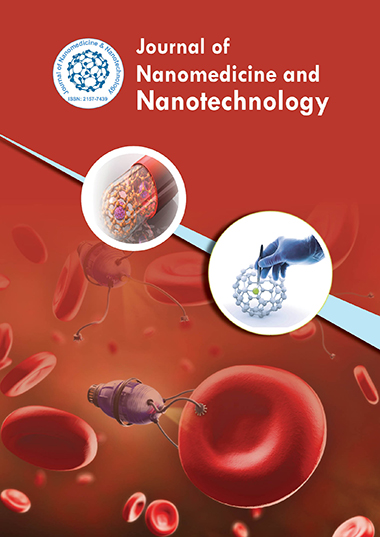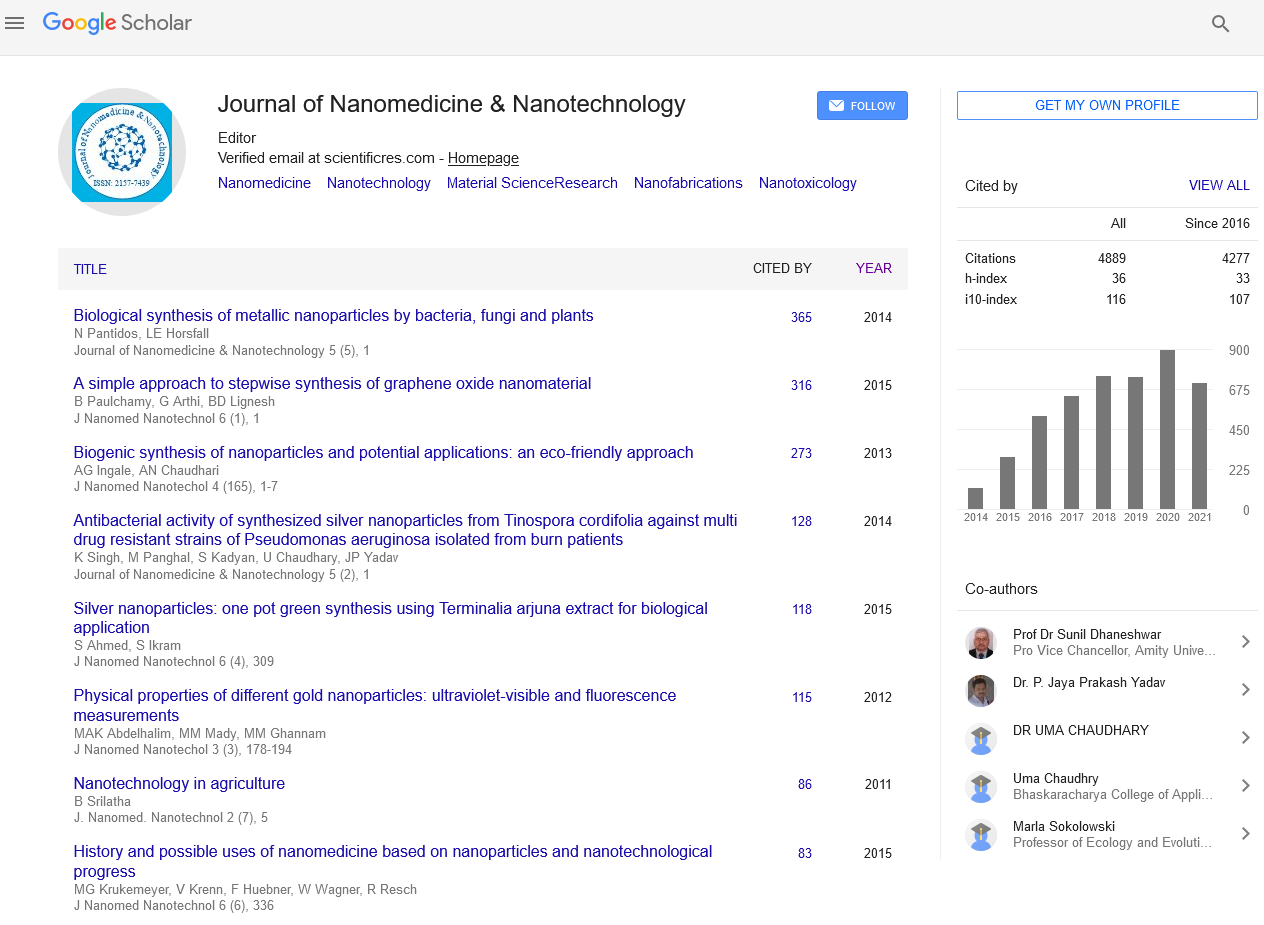Indexed In
- Open J Gate
- Genamics JournalSeek
- Academic Keys
- JournalTOCs
- ResearchBible
- China National Knowledge Infrastructure (CNKI)
- Scimago
- Ulrich's Periodicals Directory
- Electronic Journals Library
- RefSeek
- Hamdard University
- EBSCO A-Z
- OCLC- WorldCat
- SWB online catalog
- Virtual Library of Biology (vifabio)
- Publons
- MIAR
- Scientific Indexing Services (SIS)
- Euro Pub
- Google Scholar
Useful Links
Share This Page
Journal Flyer

Open Access Journals
- Agri and Aquaculture
- Biochemistry
- Bioinformatics & Systems Biology
- Business & Management
- Chemistry
- Clinical Sciences
- Engineering
- Food & Nutrition
- General Science
- Genetics & Molecular Biology
- Immunology & Microbiology
- Medical Sciences
- Neuroscience & Psychology
- Nursing & Health Care
- Pharmaceutical Sciences
Editorial - (2025) Volume 16, Issue 1
Polymer-Nanoparticle Hybrid Systems for Oral Drug Delivery to the Lymphatic System
Saud Al-Mansour*Received: 01-Jan-2025, Manuscript No. jnmnt-25-28323; Editor assigned: 03-Jan-2025, Pre QC No. jnmnt-25-28323 (PQ); Reviewed: 16-Jan-2025, QC No. jnmnt-25-28323; Revised: 23-Jan-2025, Manuscript No. jnmnt-25-28323 (R); Published: 31-Jan-2025, DOI: 10.35248/2157-7439.24.16.776
Abstract
INTRODUCTION
Oral drug delivery remains one of the most widely used and convenient methods for administering pharmaceuticals. However, the gastrointestinal (GI) tract presents significant barriers for the effective absorption of many therapeutic agents, particularly those with low bioavailability or those that require direct access to the lymphatic system for enhanced efficacy. The lymphatic system plays a crucial role in immune responses and the transport of lipophilic molecules and macromolecules. Targeting the lymphatic system via oral delivery can be particularly beneficial for drugs involved in immunotherapy, cancer treatment, and lymphatic diseases. To overcome the challenges associated with direct lymphatic drug delivery, polymer-nanoparticle hybrid systems have emerged as promising carriers capable of enhancing the bioavailability and targeting efficiency of therapeutic agents. This article explores the use of polymer-nanoparticle hybrid systems for oral drug delivery to the lymphatic system, focusing on their design, mechanisms, advantages, and future directions in drug delivery [1].
CHALLENGES IN ORAL DRUG DELIVERY TO THE LYMPHATIC SYSTEM
Oral drug delivery involves complex physiological processes, including dissolution, absorption, and first-pass metabolism in the liver, which can reduce the bioavailability of therapeutic agents. Drugs that need to target the lymphatic system face additional challenges, as the lymphatic vessels are not readily accessible by conventional oral delivery systems. After oral administration, drugs must pass through the intestinal wall and enter the bloodstream via the mesenteric lymphatic system, which then drains into the systemic circulation. However, the efficiency of this process is often limited by the permeability of the intestinal epithelium, enzymatic degradation, and the competitive absorption of drugs into the bloodstream. Lymphatic drug delivery is particularly important for lipophilic compounds, vaccines, and immunomodulatory agents, as the lymphatic system facilitates their transport and enhances their effectiveness. The lymphatic system also plays a crucial role in drug distribution to tissues, such as lymph nodes and the spleen, which can be essential for treatments targeting cancer, infections, or autoimmune disorders. Therefore, developing strategies to improve the targeted delivery of drugs to the lymphatic system via oral administration is a critical area of research in pharmaceutical development [2].
POLYMER-NANOPARTICLE HYBRID SYSTEMS: DESIGN AND MECHANISMS
Polymer-nanoparticle hybrid systems combine the benefits of both polymeric materials and nanoparticles to improve drug delivery efficiency. These hybrid systems leverage the unique properties of nanoparticles, such as their small size, high surface area, and ability to encapsulate a wide range of drugs, with the advantages of polymeric materials, such as biodegradability, biocompatibility, and the ability to modify drug release profiles. In the context of oral drug delivery to the lymphatic system, polymer-nanoparticle hybrid systems can be designed to enhance the permeability of drugs across the intestinal mucosa and facilitate their uptake by the lymphatic vessels. These systems often incorporate nanoparticles made from biocompatible polymers, such as poly(lactic-co-glycolic acid) (PLGA), chitosan, or polycaprolactone, which can encapsulate both hydrophilic and lipophilic drugs. The polymer matrix provides stability and controlled release of the drug, while the nanoparticle structure ensures efficient cellular uptake [3]. The mechanism by which polymer-nanoparticle hybrid systems target the lymphatic system involves a combination of physical and biochemical processes. Nanoparticles can enhance the uptake of drugs by intestinal epithelial cells through mechanisms such as endocytosis, transcytosis, and microfold (M) cell-mediated uptake. M cells, located in the Peyer's patches of the intestines, play a key role in transporting antigens and other macromolecules from the lumen to the lymphatic system. By functionalizing the nanoparticles with ligands that specifically target M cells or other receptors involved in lymphatic transport, the hybrid systems can enhance the targeted delivery of drugs to the lymphatic system [4]. Additionally, the size and surface charge of the nanoparticles can be engineered to promote lymphatic uptake. Nanoparticles within the size range of 10-200 nm are ideal for lymphatic transport, as they can efficiently enter the lymphatic capillaries. Surface modifications with hydrophilic or amphiphilic polymers can also enhance the interaction of nanoparticles with the mucosal layer, improving drug absorption and retention in the intestinal tract [5].
ADVANTAGES OF POLYMER-NANOPARTICLE HYBRID SYSTEMS FOR LYMPHATIC DRUG DELIVERY
Polymer-nanoparticle hybrid systems offer several advantages for oral drug delivery to the lymphatic system. One of the key benefits is enhanced bioavailability. By protecting drugs from enzymatic degradation in the GI tract and facilitating their transport across the intestinal epithelium, these hybrid systems improve the overall absorption of therapeutic agents. The nanoparticles can also be engineered to release the drug in a controlled manner, prolonging the therapeutic effect and reducing the frequency of administration. Another significant advantage is the targeted delivery to the lymphatic system. By using surface modifications and nanoparticle size optimization, these hybrid systems can selectively target M cells and other components of the lymphatic system, ensuring that drugs are transported efficiently to the lymph nodes, spleen, or other tissues involved in immune responses. This targeted delivery can enhance the efficacy of vaccines, immunotherapies, and treatments for lymphatic diseases, as it allows for localized drug action and minimizes systemic side effects [6]. Polymer-nanoparticle hybrid systems are also versatile in their ability to encapsulate a wide range of drug types, including proteins, peptides, nucleic acids, and small molecules. This makes them suitable for the delivery of a broad spectrum of therapeutics, including those used in cancer immunotherapy, vaccine development, and treatments for infectious diseases or autoimmune disorders. The ability to co-deliver multiple agents or combine drug delivery with immunomodulatory agents further enhances the therapeutic potential of these systems.
APPLICATIONS IN DRUG DELIVERY TO THE LYMPHATIC SYSTEM
Polymer-nanoparticle hybrid systems have shown promise in several areas of drug delivery to the lymphatic system. One of the most notable applications is in vaccine delivery. Many vaccines, especially those targeting infectious diseases, rely on the activation of the immune system via the lymphatic system. By delivering antigens or adjuvants directly to the lymph nodes, polymer-nanoparticle hybrid systems can enhance the immune response and improve vaccine efficacy. In cancer immunotherapy, the lymphatic system plays a crucial role in the activation of immune cells that can target and eliminate tumor cells. Nanoparticle-based drug delivery systems can be used to deliver cancer vaccines, immune checkpoint inhibitors, or cytokines to the lymphatic system, where they can activate T cells and other immune cells to mount a targeted immune response against the tumor. Similarly, polymer-nanoparticle hybrid systems can be used to deliver drugs that specifically target lymphatic tumors, such as those associated with lymphoma or other cancers of the lymphatic system [7]. Another important application is in the treatment of autoimmune diseases, where the lymphatic system plays a central role in the dysregulated immune response. By modulating the immune system through targeted drug delivery to the lymph nodes, polymer-nanoparticle hybrid systems can help to reprogram immune cells and restore immune balance.
CHALLENGES AND FUTURE DIRECTIONS
While polymer-nanoparticle hybrid systems hold great promise, several challenges must be addressed before they can be widely adopted for clinical use. One of the main challenges is the optimization of nanoparticle properties, such as size, surface charge, and biodegradability, to ensure efficient lymphatic targeting and minimize potential toxicity. Additionally, the long-term stability and fate of nanoparticles in the body, including their potential accumulation in organs such as the liver and spleen, must be carefully evaluated [8]. Another challenge is the variability in the absorption and transport of nanoparticles across the intestinal epithelium, which can be influenced by factors such as diet, age, and disease state. Therefore, further research is needed to understand the mechanisms of nanoparticle uptake in the GI tract and to develop strategies for improving the reproducibility and predictability of drug delivery. Despite these challenges, the potential of polymer-nanoparticle hybrid systems for oral drug delivery to the lymphatic system is vast [9]. Ongoing advancements in nanoparticle design, surface functionalization, and controlled release technologies will likely lead to the development of more effective and targeted therapies for a wide range of diseases [10].
CONCLUSION
Polymer-nanoparticle hybrid systems offer a promising strategy for enhancing oral drug delivery to the lymphatic system. By improving the bioavailability of drugs and facilitating their targeted transport to lymphoid tissues, these hybrid systems can significantly enhance the efficacy of treatments for cancer, infections, autoimmune disorders, and vaccine delivery. While challenges remain, ongoing research into nanoparticle design, surface modification, and lymphatic targeting holds great promise for the future of oral drug delivery systems. With continued innovation and optimization, polymer-nanoparticle hybrid systems are poised to revolutionize drug delivery strategies, improving patient outcomes and reducing systemic side effects.
REFERENCES
- Kamaly N, Yameen B, Wu J. Degradable Controlled-Release Polymers and Polymeric Nanoparticles: Mechanisms of Controlling Drug Release. Chemical Reviews. 2016; 116(4): 2602-2663.
- Lee K, Anderson R. Nanoparticles in Biology and Medicine: Small Structures with Big Potential. Adv healthc mater. 2022; 11(19): 2100713.
- Harrison OJ, Smith SJ, Sperandio M. Detection and Discrimination of Intact and Cleaved E-Cadherin Fragment Release from Cell Surfaces: Implications for Understanding the Role of E-Cadherin in Angiogenesis and Cancer Progression. J Proteome Res. 2023; 22(1): 683-693.
- Hoshyar N, Gray S, Han H. The effect of nanoparticle size on in vivo pharmacokinetics and cellular interaction. Nanoscale. 2016; 8(13): 6731-6747.
- Zhang S, Bellinger A, Genshaft A. A bloodâ??brain barrierâ??penetrating gut-microbe-derived molecule that enhances amyloid beta deposition and cognitive impairment in a mouse model. Science Advances. 2021; 7(23): eabf1773.
- Jones LW, Anderson T. Exercise Oncology: Historical Perspective and Future Directions. Cold Spring Harb Perspect Med. 2023;13(6): a037038.
- Lee JH, Wilson W. Virus-Mimicking Phytosomes for Drug Delivery in Cancer. Pharmaceutics. 2020; 12(3): 229.
- White KA, Parker N. Expanding the Scope of Enzyme Specificity for Genome Engineering. J Am Chem Soc. 2021; 143(45):18445-18450.
- Garcia JR, Wilson W. RNA Delivery and Therapeutics for Oncology. Trends Pharmacol Sci. 2021; 42(11): 905-915.
- Tong R, Chiang HH, Kohane DS. Photoswitchable nanoparticles for in vivo cancer chemotherapy. Proc Natl Acad Sci. 2020; 110(46): 19048-19053.
Indexed at, Google Scholar, Crossref
Indexed at, Google Scholar, Crossref
Indexed at, Google Scholar, Crossref
Indexed at, Google Scholar, Crossref
Citation: Al-Mansour S (2025) Polymer-Nanoparticle Hybrid Systems for Oral Drug Delivery to the Lymphatic System. J Nanomed Nanotech. 16: 776.
Copyright: ©2025 Al-Mansour S. This is an open-access article distributed under the terms of the Creative Commons Attribution License, which permits unrestricted use, distribution, and reproduction in any medium, provided the original author and source are credited


